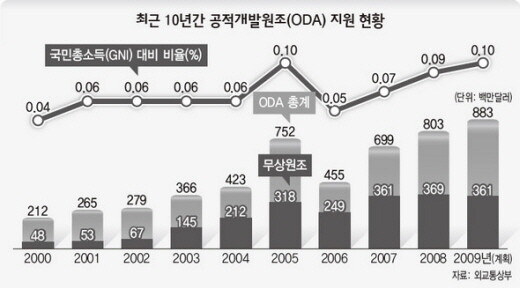hankyoreh
Links to other country sites 다른 나라 사이트 링크
S. Korea becomes first former aid recipient to join OECD Development Assistance Committee

South Korea has become the 24th member nation in the Development Assistance Committee (DAC) in the Organisation for Economic Co-operation and Development (OECD). This marks the first time since the OECD was established in 1961 that a country has joined the “advance nations’ assistance club” after transitioning from an aid recipient to a donor.
Representatives of the DAC’s 23 member nations met at the OECD Secretariat in Paris, France on Wednesday (local time) and held a special meeting to deliberate over South Korea’s admission as a member. The representatives voted unanimously to admit the country, which will become a formal DAC member nation as of Jan. 1, 2010. The Ministry of Foreign Affairs and Trade (MOFAT) said that the DAC member nations placed great significance at Wednesday’s meeting on the admission of South Korea as a nation that has gone from being an aid beneficiary to a donor.
The DAC is affiliated with the OECD, and prior to the decision Wednesday, it was the only one of the OECD’s 25 organizations that South Korea had not joined as a member. The DAC discusses and coordinates official development assistance (ODA) for impoverished developing nations through policy dialogue among member nations, and its members provide more than 90 percent of the world’s aid. Twenty-three out of the 30 OECD member nations, including advanced nations and European Union member states, are currently active as members. South Korea’s admission makes it the 24th member nation. The last time the DAC admitted a new member was in 1999 when Greece joined the committee.
To become a DAC member, a country’s aid must exceed 0.2 percent of gross national income (GNI) or one billion U.S. dollars, and it must have appropriate aid organizations, policies and strategies in place. South Korea’s ODA last year amounted to approximately 830 million dollars, or roughly 0.09 percent of GNI. This year, the government is planning ODA of around 883 million dollars, and the percentage of GNI is expected to surpass 0.1 percent for the first time. Oh Joon, deputy minister for multilateral and global affairs at the Ministry of Foreign Affairs and Trade, said, “By 2015, we will increase our amount of official development assistance to around 0.25 percent of gross national income.” This would be equivalent to around three billion dollars.
As it joins the DAC, South Korea faces the task of improving the quality of its ODA. Around 70 percent of the country’s ODA is grant aid, while in advanced nations the level is as much as 90 percent. Generally, concessional loans have prompted concerns that rather than contributing to their sustainable development they increase indebtedness in the poorest nations, which lack the ability to repay them. Additionally, some 75 percent of all South Korean aid is tied aid, in which assistance is provided on the condition that it is accompanied by South Korean businesses and products, with the goals of expanded exports and resource development. Critics have said this form goes against the spirit of aid, in that it involves selecting areas for support according to South Korean interests rather than what is needed in the recipient nation.
MOFAT has announced plans to reduce the percentage of tied aid to 25 percent by 2015. It also said that it would increase efforts to promote the efficiency of aid, strengthen the link between concessional loans and grant aid, and pursue the enactment of a basic law on ODA.
Please direct questions or comments to [englishhani@hani.co.kr]
Editorial・opinion
![[Column] Has Korea, too, crossed the Rubicon on China? [Column] Has Korea, too, crossed the Rubicon on China?](https://flexible.img.hani.co.kr/flexible/normal/500/300/imgdb/original/2024/0419/9317135153409185.jpg) [Column] Has Korea, too, crossed the Rubicon on China?
[Column] Has Korea, too, crossed the Rubicon on China?![[Correspondent’s column] In Japan’s alliance with US, echoes of its past alliances with UK [Correspondent’s column] In Japan’s alliance with US, echoes of its past alliances with UK](https://flexible.img.hani.co.kr/flexible/normal/500/300/imgdb/original/2024/0419/2317135166563519.jpg) [Correspondent’s column] In Japan’s alliance with US, echoes of its past alliances with UK
[Correspondent’s column] In Japan’s alliance with US, echoes of its past alliances with UK- [Editorial] Does Yoon think the Korean public is wrong?
- [Editorial] As it bolsters its alliance with US, Japan must be accountable for past
- [Guest essay] Amending the Constitution is Yoon’s key to leaving office in public’s good graces
- [Editorial] 10 years on, lessons of Sewol tragedy must never be forgotten
- [Column] A death blow to Korea’s prosecutor politics
- [Correspondent’s column] The US and the end of Japanese pacifism
- [Guest essay] How Korea turned its trainee doctors into monsters
- [Guest essay] As someone who helped forge Seoul-Moscow ties, their status today troubles me
Most viewed articles
- 1[Column] The clock is ticking for Korea’s first lady
- 2After 2 months of delayed, denied medical care, Koreans worry worst may be yet to come
- 3[Column] Has Korea, too, crossed the Rubicon on China?
- 4US overtakes China as Korea’s top export market, prompting trade sanction jitters
- 5[Correspondent’s column] In Japan’s alliance with US, echoes of its past alliances with UK
- 6Hong Se-hwa, voice for tolerance whose memoir of exile touched a chord, dies at 76
- 7All eyes on Xiaomi after it pulls off EV that Apple couldn’t
- 8[News analysis] After elections, prosecutorial reform will likely make legislative agenda
- 9More South Koreans, particularly the young, are leaving their religions
- 10John Linton, descendant of US missionaries and naturalized Korean citizen, to lead PPP’s reform effo